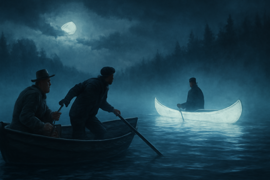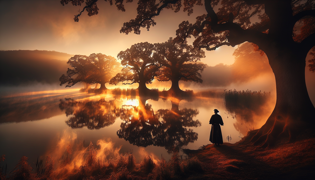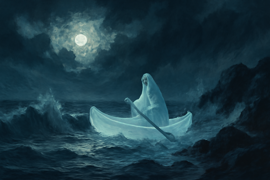Introduction
In the hushed hours when the last traces of daylight vanish beyond the horizon and the cadence of waves softens into a rhythmic hush, Cabrits Bay reveals a secret known to few. Nestled on the northwestern coast of Dominica, this sheltered inlet is framed by the ancient ruins of Fort Shirley and the silhouette of towering emerald hills. On nights when the moon rides high and the mist drapes the water like a lace veil, fishermen pause mid-cast to watch a faint glow glide across the bay. They say it is the Phantom Canoe, carrying the spirits of ancestors who once made these shores their home. These spectral guardians, clad in traditional garments and paddling with silent oars, drift close to the water’s edge and vanish as if swallowed by the mist itself. Locals speak of the canoe in reverent whispers, recounting how generations ago, their elders first felt its presence—a warm, guiding light in times of peril, an unseen hand steering lost vessels away from jagged reefs. Over time, the legend has woven itself into the fabric of island life, linking the present to a storied past. In homes along the bay, families pass down tales of loved ones who gaze from that phantom vessel, offering protection and wisdom to those who respect the land and sea. Even today, when a sudden squall rises or a lone traveler stirs at the water’s edge, there comes an uncanny stillness, and the hush is broken only by the soft lapping of the oars. As you read these words, imagine stepping onto the shore at Cabrits Bay, feeling the salt-kissed breeze and sensing the subtle pulse of history flowing beneath the surface. This is not merely a ghost story but a living legacy—one that invites every listener to remember the bond between the living and the departed, and to honor the ancestral guardians of Dominica’s coast.
Origins of the Phantom Canoe
Long before Cabrits Bay became a refuge for traders and settlers, it was the gathering place of indigenous Kalinago communities who revered the spirits of land and sea. In those early times, when canoes carved from single trunks of cedar and mahogany glided effortlessly along the coast, the elders would perform nightly rites to honor their ancestors. They built small altars on hidden beaches, offering cassava bread and freshwater in clay bowls, inviting the benevolent spirits to join them in safeguarding their families and catch. As colonial ships arrived in search of sugar and indigo, whispers began that the canoe, once a living vessel of wood and sail, had transcended mortality. They spoke of nights when the indigenous rituals were forbidden and the bay fell under uneasy occupation. Yet, through every storm of conflict and every shift of power, the Phantom Canoe endured—a silent testament to those who would not be cast away by conquest or time.

Image provided above is a depiction of the bay at dawn, long after the first sightings of the ethereal vessel. It illustrates the scene of fishermen startled by a glowing canoe drifting through the fog.
Across decades, seafaring families recorded accounts in journals and song. They described how the canoe, without wind or engine, made no wake, seemed to move on an invisible current, its lantern hanging at the bow flickering in green and white hues. When the British fort was under siege in the eighteenth century, marines claimed they saw the canoe slip past blockading ships, delivering water and provisions to those trapped within the ramparts. Over time, the legend passed from timber to parchment, from storyteller to bard, shaping the spiritual tapestry of Dominica. Even as modern boats patrolled the harbor with engines humming, the old tales remained, reminding each generation that some vessels are propelled not by sails or motors, but by memory, faith, and the deep bonds of kinship.
To this day, the oldest families along the bay speak of the canoe’s first recorded appearance in colonial records, when a mariner’s log noted a faint shimmer beneath the cliffs of Fort Shirley. He wrote that his compass spun wild, and time itself felt suspended until the apparition faded. Scholars who later studied the entry found no logical explanation—no electrical phenomena, no secret lantern parade. Instead, they found traces of something far older: a collective reverence for ancestors who refused to be forgotten. This reverence, channeled through the tale of the phantom canoe, endures as a cultural beacon in Dominica’s living folklore. It reminds all who hear it that the past is never truly gone, that tonight, when the moon is full and the sea is calm, it paddles close by, guiding hearts and hulls away from danger.
Whispers in the Night
In the quiet hours when rapped shutters yield to the lullaby of the tide, Cabrits Bay becomes alive with soft disturbances—subtle ripples, hushed footfalls on sand, and the faintest echo of paddles splitting water. Islanders tell of the moment a hush descends over the beach, as though the music of cicadas and frogs has been paused by unseen hands. Then comes a swaying glow on the horizon, weaving between rocky outcrops and drifting low above the surface like a firefly star. With each step closer, listeners swear they hear whispers—words half-lost to time but rich with the cadence of ancient language. Some claim the canoe carries pleas from forgotten ancestors, urging unity in times of strife. Others suggest it shares riddles of the wind, riddles that, if solved, reveal hidden coves and safe passages for fishermen battling crescents of storms. In these whispers, islanders find a living archive of guidance and safeguard.

Whether perched on a jagged rock or standing knee-deep in the shallows, witnesses recount voices neither male nor female, but melding tones as varied as the palm fronds rustling overhead. They speak in gentle timbre but with insistent urgency—echoes that seem to emerge from the canoe’s keel itself. On one hush-laden night, two young sisters walked the shore when the canoe glided into view. The whispers formed a lullaby that soothed their fear, teaching them a melody reminiscent of lullabies sung by mothers long gone. As they hummed the tune in their dreams, they awoke remembering safe routes home for a fisherman lost in a sudden squall. Word of that rescue spread in the village, and soon families paused their routine chores, calling out thanks to the canoe’s guardians.
Through Carnival and harvest festivals, parents hush boisterous children with tales of that whispering light, reminding them that true strength often comes in soft voices and patient guidance. Poets and musicians have woven lines about the canoe’s haunting melody into songs that echo in open-air markets, bridging ancient chants with reggae rhythms. Elders insist that those who truly listen will carry the whispers in their hearts forever, a gentle compass guiding them through life’s tempests. And so, beneath the watchful moon, Cabrits Bay carries on its ancient dialogue with the spirits, each whisper a link in a chain that binds the living to those who came before.
Guardians of the Coast
When storm clouds gather on the horizon and the wind tears through tropical palms, Cabrits Bay takes on a different magnetism, drawing sailors homeward with a sense of foreboding and awe. Legends say that in these moments, the Phantom Canoe reveals its greatest power: to guide vessels safely through angry seas. Captains who have weathered sudden gales recount an inexplicable calm that envelops their decks as the canoe appears, its hull slicing glassy channels through roiling waves. At times, they glimpse candles flickering along its rails, each flame marking the presence of a fallen mariner who once navigated these waters. With silent signals in the shifting light, the spirits direct captains around jagged reefs and toward welcoming harbors.

One historic account, preserved in faded letters at a Creole heritage museum, describes the cargo schooner Morning Star caught in a maritime hurricane in the mid-nineteenth century. The crew, convinced their end had come, witnessed a slender canoe emerge behind breaker lines, its paddles guiding a narrow path bordered by sharp rocks. Under the watchful gaze of ancestral forms, the crew steered their vessel through the gap, and within moments, the storm subsided as if led away by that spectral glare. Survivors spoke later of a deep hum emanating from the canoe—a call to honor the sacred covenant between the living and the dead.
Even today, fishermen who venture too far in search of whelks or conch heed the canoe’s silent warnings. Some leave offerings of freshly caught fish or carved shells along the shoreline, gestures of gratitude to the unseen crew. During prime coconut harvests, families build small cairns of fruit beside hidden coves, believing the offerings ensure safe passage and bountiful catches. These customs, woven into the tapestry of daily life, echo the canoe’s original purpose: not merely to ferry spirits, but to uphold a bond of stewardship over land and sea. In honoring the Phantom Canoe, the people of Dominica honor their past, protect their present, and guide their future—proving that the most enduring vessels are those built on memory, respect, and the wisdom of ancestors.
Conclusion
As dawn’s first light warms the coral reefs and swallows the last tendrils of mist, Cabrits Bay settles once more into its daytime rhythm of fishing nets and festival drums. Yet the memory of the Phantom Canoe lingers in every whisper of wave against hull and in every tale told by grandmothers rocking on verandas. In Dominica, this legend endures not as a mere ghost story but as a living testament to the blending of cultures, the reverence for ancestors, and the deep connection between people and the sea. The canoe—silent, spectral, and unwavering—reminds each generation that we are stewards of the stories and souls who came before us. When twilight falls again and you stand by Cabrits Bay’s shore, listen closely for the soft scrape of oars against water. If you are patient, you might catch the glimmer of lantern light and sense the gentle presence of guardians guiding you, urging you to remember that wisdom and protection often drift unseen until we open our hearts to the unseen currents that bind us all.


















